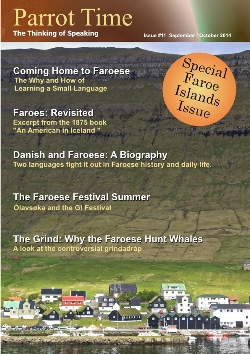Revisted
The Faroe Islands

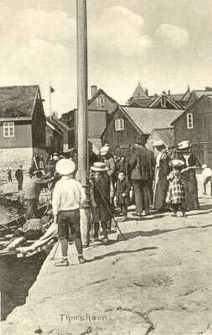 Old postcard of Tórshavn shows the port from 1910 The town, named after the god Thor, ordinarily contains about eight hundred inhabitants, many of whom are Danes, and this element of the population was very demonstrative for obvious reasons; the place was now crowded with strangers from all parts of the island to see the king, who had been expected the day before. His majesty occupied the governor's house on the hill, and the road thereto from the arch of welcome on the shore had been strewn with flowers. His officers were disposed in the houses of the principal residents, to a degree that the operations of the post-office, the schools, and the courts of justice, were practically suspended. Passing the night on board our steamer, as we always did when in port, we retired at 11pm, it still being quite light. We went ashore the next day, Sunday, to attend church, whither the king and his party went to participate in a simple, tedious medley of inaudible prayer, poor singing, and a prosy sermon in the Danish language. The wash of the waves made a landing difficult on the slippery rocks, the only wharves being irregular heaps of stones; it required considerable dexterity to avoid getting wet feet and being thrown down; but friendly hands were extended to save us, and we landed in good condition. Our boats carried the American and English flags, which the people seemed to look at with more enthusiasm than at the Danish. 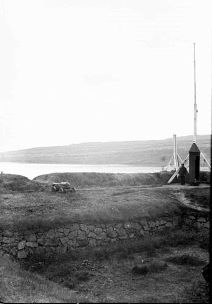 Skansin, the old fort of Tórshavn, Faroe Islands, 1899 The crowds were well dressed, and every thing, as yesterday, had a gala look, on land and water, as far as flags could make it. We visited various public buildings and private residences, but could not get access to any officials as all were busy at breakfast with their stranger guests. While waiting for the opening of the church, after looking at the tombstones in the neat church-yard, we ascended a hill behind the useless fort, the only decent walk in the place, and thence had a fine view of the town, its harbor, the gardens and fields of grass and hardy vegetables, and the mist covered mountains in the distance. At 11am we went to the church, where seats had been reserved for us; it was of the plainest description, with uncushioned seats innocent of paint, accommodating a few hundred persons on the floor and small gallery. The altar, over which was a faded picture of the entombment of Christ, was at the rear of a space raised a few inches above the floor, and in this space seats had been arranged for the king and his suite. Soon the bells began to ring, the great doors were thrown open, and the king entered, quietly walking with the prince Waldemar to his seat, bowing on each side as he passed along. He was simply dressed in the Danish naval uniform with a few decorations; his appearance was dignified, his expression kind and genial, with an entire absence of that hauteur and formality which some potentates think indicate the divinity of royalty. Indeed, had he made a display, in proportion to that of some of his followers, the islanders would have liked it better, as most of them looked upon the visit as a mere pageant, without any political significance or possible benefit to them. This gentle-mannered race seemed out of place amid the rugged scenery, bleak rocks, howling winds, and stormy seas of the Faroes. The audience were quiet and devotional, joining in the hymns with fervent but unmusical voices. The women looked care-worn and prematurely old, and I saw no signs of beauty. There was no pretension to dress, though upstairs I caught a glimpse of some Paris-looking hats, doubtless accompanied by three-button gloves. As in Iceland, the people here are all Lutherans; but the altar, the burning candles, and the dress, attitudes, and tones of the clergyman, gave a semi-Romish character to the service, at variance with the independent, intelligent character of the audience. I think all were glad when the ceremony was over, as neither fresh ideas nor fresh air were supplied during its continuance. The clergyman was enclosed in a boxlike pulpit on one side, high above the heads of his congregation; he looked very queer with his stiff, plaited Elizabethan ruff about his neck. The royal party seemed bored by the platitudes of the sermon, and, at the close of the services, departed, before the audience, with great alacrity. 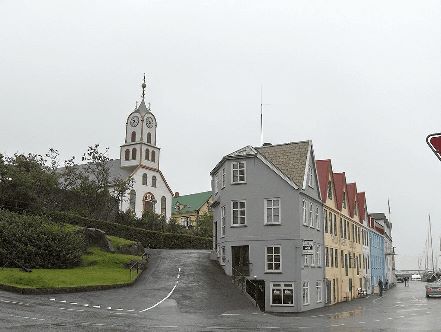 Tórshavn Cathedral (Havnar Kirkja) and harbourside buildings, Faroe Islands After the service the king and his party returned to the frigate to dinner, to which many of the people had been invited; the vessel was about two miles from shore, and the sea quite rough, yet boat-load after boat-load, including many ladies, went to and fro all the afternoon and late into the night. Some of the guests, high in church and state, are currently reported to have imbibed more stimulating drinks than were consistent with Sunday gravity or steady locomotion; judging from the hilarity, and evident disarrangement of ruffs, epaulettes, and hats, this may safely be set down as a fact. The people were admitted to see the tables and the cabins, the former rich with gold and silver, and the latter gaily furnished; the ship was, however, of the old-fashioned type, slow, with many hundred tons of old iron in the shape of cannon, whose space on such a long and rough voyage had much better have been occupied by coal, saving thereby much labor and time. 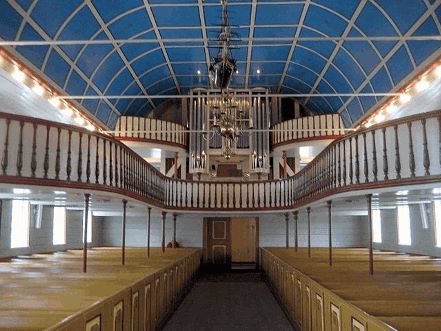 Interior of the Havnar Kirkja in Tórshavn, Faroe Islands Among other places, we visited the school, occupied then by the guests, and were pleased to see in this distant island modern apparatus for physical out-door exercise. Living as they do chiefly on barley meal, milk, sheep, fish, and sea-fowl and their eggs, the health of the children is often affected by the foul air of the houses; the school, therefore, not only educates the mind, but does much to invigorate the body. This gentle-mannered race seemed out of place amid the rugged scenery, bleak rocks, howling winds, and stormy seas of the Faroes; we should rather have expected a coarse, bold, semi-savage horde, as the legitimate descendants of the Vikings of old. The king was everywhere saluted with respect, but not with enthusiasm, except by his Danish subjects; the same indifference I noticed in Iceland. The old Scandinavian independence, almost contempt for royalty, as such, was publicly manifest; they had nothing to ask, and it never entered their heads that a king of Denmark, the first that ever visited these islands, had the inclination, if he had the power, to grant them any political favors. His visit they attributed to curiosity, and they gratified their own at the same time at his expense.  Eystaravág, the eastern bay in the harbour of Tórshavn, Faroe Islands. The day had been windy and rainy, and the night was unpromising; we could see that the waves outside were dashing with violence against the rocky shores, and we retired, hoping for a calmer sea the next day. Early the next morning we sailed, in advance of the royal vessels, for Iceland, 320 miles to the north-west, which we ought to reach, wind and weather permitting, in about forty hours. The Faroese are long-lived, and the climate, notwithstanding its occasional severity and sudden changes, must be a healthy one, or, as in Iceland, the race would long ago have been exterminated by the utter absence of all sanitary precautions to prevent disease. |
| Revisited - The Faroe Islands | |||||||
| Writer: | Samuel Kneeland | ||||||
| Images: | |||||||
| |||||||
| Sources: | |||||||
| |||||||
Miranda Metheny retains all copyright control over her images. They are used in Parrot Time with her expressed permission.
All images are Copyright - CC BY-SA (Creative Commons Share Alike) by their respective owners, except for Petey, which is Public Domain (PD) or unless otherwise noted.
comments powered by Disqus












